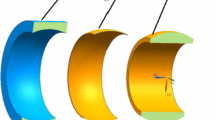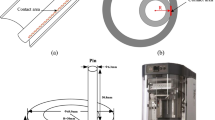Abstract
For many decades, scientists in the field of boundary tribology have been working to find an excellent and environment friendly anti-wear additives to minimize wearing of the boundary equipment by improving the anti-wearing ability of the boundary lubricants. Four (4) anti-wear lubricant additives with better properties were carefully designed with the aids of QSPR and MD simulation methodologies. Out of the four newly designed additives, 2, 3, 5-trimethylheptyl acetate with the anti-wear property of 2.0802 mm was found to have better anti-wear lubricant property than its co-additives as well as the standard AW additive, Zinc dipropyl dithiophosphate (ZDDP). All the additives were found to have better boundary dynamic binding energy as well as high dynamic binding temperatures on steel-simulated coated surface than on DLC-coated surface. The boundary dynamic binding energy of all these anti-wear additives was found to be better than the ZDDP. And they could improve the anti-wear property of lubricant at elevated temperature without being decomposed since they have a high dynamic binding tribological temperature. Moreover, all these new anti-wear lubricant additives structures do not contain zinc (catalytic converters deactivator), sulfur (acidic oxide), and phosphorus (exhaust pipe ashes producer) and could be used to replace the widely used additive, ZDDP, which contains zinc and phosphorus and has less active (3.284 mm) additive property. Due to their better structures and properties correlation ability, these two methods could be used to provide a theoretical framework for engineers and other researchers to design a better anti-wear base oil additive before laboratory synthesis.







Similar content being viewed by others
References
Holmberg K, Andersson P, Erdemir A (2012) Global energy consumption due to friction in passenger cars. Tribol Int 47:221–234
Holmberg K, Andersson P, Nylund NO, Makela K, Erdemir A (2014) Global energy consumption due to friction in trucks and buses. Tribol Int 78:94–114
Wen SZ, Huang P (2012) Principles of tribology, 4th edn. Tsinghua University Press, Beijing
Le-Cao D, Khac BC, Le CT, Kim YS, Chung KH (2018) Friction characteristics of mechanically exfoliated and CVD-grown single-layer MoS2. Friction 6(4):395–406
Onodera T, Morita Y, Suzuki A, Koyama M, Tsuboi H, Hatakeyama N, Endou A, Takaba H, Kubo M, Dassenoy F et al (2009) A computational chemistry study on friction of h-MoS2. Part I. Mechanism of single sheet lubrication. J Phys Chem B 113(52):16526–16536
Ansari R, Ajori S, Motevalli B (2012) Mechanical properties of defective single-layered graphene sheets via molecular dynamics simulation. Superlattices Microstruct 51(2):274–289
Smolyanitsky A, Killgore JP (2012) Anomalous friction in suspended graphene. Phys Rev B 86(12):125432
Yoon HM, Jung Y, Jun SC, Kondaraju S, Lee JS (2015) Molecular dynamics simulations of nanoscale and subnanoscale friction behavior between graphene and a silicon tip: analysis of tip apex motion. Nanoscale 7(14):6295–6303
Tang Z, Li S (2014) A review of recent developments of friction modifiers for liquid lubricants (2007-present). Curr Opin Solid State Mater Sci 18:119–139
Chou CC, Lee SH (2008) Rheological behavior and tribological performance of a nanodiamond-dispersed lubricant. J Mater Process Technol 201:542
Hernández-Battez A, González R, Viesca JL, Fernández JE, Díaz Fernández JM, Machado A, Chou R, Riba J (2008) CuO, ZrO2 and ZnO nanoparticles as antiwear additive in oil lubricants. Wear 265:422
Jiao D, Zheng S, Wang Y, Guan R, Cao B (2011) The tribology properties of alumina/silica composite nanoparticles as lubricant additives. Appl Surf Sci 257:5720
Rudnick LR (2010) Lubricant additives. Chemistry and applications, 2nd edn. CRS Press, Boca Raton, p 796
Zhang B, Xu B, Xu Y, Gao F, Shi F, Wu Y (2011) Cu nanoparticles effect on the tribological properties of hydrosilicate powders as lubricantadditive for steel–steel contacts. Tribol Int 44:878
Hong H, Riga AT, Cahoon JM, Vinci JN (1993) Evaluation of overbased sulfonates as extreme-pressure additives in metalworking fluids. Lubr Eng 49:19–24
McDonald RA (2009) Zinc Dithiophosphates. In: Rudnick LR (ed) Lubricant additives, 2nd edn. Marcel Dekker Inc., New York, pp 51–62
Abdulfatai U, Uzairu A, Uba S, Shallangwa GA (2019a) Molecular modelling and design of lubricant additives and their molecular dynamic simulations studies of Diamond-Like-Carbon (DLC) and steel surface coating. Egypt J Pet. https://doi.org/10.1016/j.ejpe.2018.12.004
Ivanciuc O, Ivanciuc T, Cabrol-Bass T (2000) 3D quantitative structure-activity relationships with CoRSA. Comparative receptor surface analysis. Application to calcium channel agonists. Analysis 28:637–642
Wong KY, Mercader AG, Saavedra LM, Honarparvar B, Romanelli GP, Duchowicz PR (2014) QSAR Analysis on tacrine-related acetylcholinesterase inhibitors. J Biomed Sci 21:84
Wang Z, Wang T, Yang G, Gao X, Dai K (2017) Estimating anti-wear properties of esters as potential lubricant based oils using QSTR models with CoMFA and CoMSIA. Friction. https://doi.org/10.1007/s40544-017-0175-5
Todeschini R. Consonni V, Mauri A, Pavan M (2012) DRAGON for widows (Software for the Calculation of Molecular Descriptors), version 6.0, TALETE srl, Milan, Italy
Rogers D, Hopfinger AJ (1994) Application of genetic function approximation to quantitative structure-activity relationships and quantitative structure property relationships. J Chem Inf Comp Sci 34:854–866
Minovski N, Zuperl S, Drgan V, Novi M (2013) Assessment of applicability domain for multivariate counterpropagation artificial neural network predictive models by minimum Euclidean distance space analysis: a case study. Anal Chim Acta 759:28–42. https://doi.org/10.1016/j.aca.2012.11.002
Moriguchi H, Ohara H, Tsujioka M (2016) History and applications of diamond-like carbon manufacturing processes. Sei Tech Rev 82:52–58
Kalin M, Kosovšek J, Remškar M (2013) Nano particle sasnovel lubricating additives in agreen, physically based lubrication technology for DLC coatings. Wear 303:480–485
Kano M, Yasuda Y, Okamoto Y, Mabuchi Y, Hamada T, Ueno T et al (2005) Ultralow friction of DLC vinpresence of glycerolmono-oleate(GMO). Tribol Lett 18:245–251
Neville A, Morina A, Haque T, Voong M (2007) Compatibility between tribological surfaces andlubricantadditives—how friction and wear reduction can be controlled by surface/lube synergies. Tribol Int 40:1680–1695
Oluwaseye A, Uzairu A, Shallangwa G, Abechi S (2017) A novel QSAR model for designing, evaluating, and predicting the anti-MES activity of new 1H-pyrazole-5-carboxylic acid derivatives. JOTCSA 4(3):739–774
Cholakov GS (2011) Towards computer aided design of fuels and lubricants (review). J Univ Chem Technol Metall 46(3):217–236
Michael PA (2004) Introduction to molecular dynamics simulation, vol 23. John von Neumann Institute for Computing, Jülich, pp 1–28
Wymyslowski A, Iwamoto N, Yuen M, Fan H (2008) Molecular modeling and multiscaling issues for electronic material applications. Springer, New York
Tropsha A (2010) Best practices for QSAR model development, validation, and exploitation. Mol Inform 29:476–488
Abdulfatai U, Uzairu A, Uba S (2019b) Molecular docking and quantitative structure-activity relationship study of anticonvulsant activity of aminobenzothiazole derivatives. Beni-Suef Univ J Basic Appl Sci 7:204–214
Netzeva TI, Worth AP, Aldenberg T, Benigni R, Cronin MTD, Gramatica P, Jaworska JS, Kahn S, Klopman G, Marchant CA, Myatt G, Nikolova-Jeliazkova N, Patlewicz GY, Perkins R, Roberts DW, Schultz TW, Stanton DT, Van De Sandt JJM, Tong W, Veith G, Yang C (2005) Current status of methods for defining the applicability domain of (quantitative) structure–activity relationships. Altern Lab Anim 33:155–173
Todeschini R, Gramatica P (1998) New 3D molecular descriptors: the WHIM theory and QAR applications. Persepect Drug Discov Design. https://doi.org/10.1023/A:1027284627085
Abdulfatai U, Uzairu A, Uba S, Shallangwa GA (2019c) Quantitative structure-properties relationship, molecular dynamic simulations and designs of some novel lubricant additives. Egypt J Pet. https://doi.org/10.1016/j.ejpe.2019.05.001
Funding
No direct funding was received for this research.
Author information
Authors and Affiliations
Corresponding author
Ethics declarations
Conflict of interest
The authors declare that they have no conflict of interest.
Research Involving Human and Animal Participants
This research does not contain any human or animal subjects.
Additional information
Publisher's Note
Springer Nature remains neutral with regard to jurisdictional claims in published maps and institutional affiliations.
Rights and permissions
About this article
Cite this article
Abdulfatai, U., Uzairu, A., Shallangwa, G.A. et al. In Silico Modeling, Prediction, and Designing of Some Anti-wear Lubricant Additives. J Bio Tribo Corros 6, 100 (2020). https://doi.org/10.1007/s40735-020-00399-y
Received:
Revised:
Accepted:
Published:
DOI: https://doi.org/10.1007/s40735-020-00399-y




